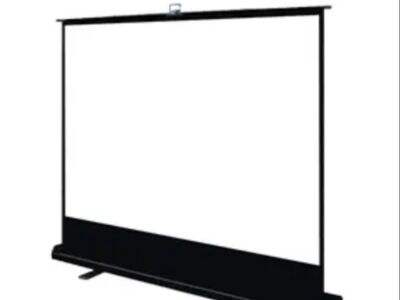Are you looking for a projection screen for your home movie room or for school presentations? Making the right choice is crucial to enjoying a great picture. In order to select a screen, you must understand the nature of the materials of which they can be made and how they would perform in different environments. We at WUPRO would like to assist you to compare any Projection screen and projector with the variety of different types of materials so that you could make use of the best-suited one.
How to Choose the Right Projection Screen Material?
Projection screens come with numerous different materials. All these have their advantages and disadvantages, so it will be quite handy to know before making any decisions. Some common materials that are used for the production of projection screens include:
White matte: This is the most common projection screen material. It is powerful, does not cost too much money, and appears bright and clear. But here's something to know: it may not do well working in rooms with a lot of light coming in. Too much light and the image on the screen won't be bright.
Gray screens are calibrated so that the image colors and blacks in a picture are boosted. They tend to do all right in slightly lit rooms. They are often used for presentations, but very bright rooms would be challenging even for gray screen for the projector, where gray light could actually wash out the picture.
High-gain: These screens reflect more light to the viewer, and with that, they can offer an even brighter picture. These are suitable for rooms with ample light. However, one of the disadvantages is that bright spots can be developed, meaning in some cases, parts of the screen might be many times brighter than others. That position can sometimes make it hard for everyone to see the picture from all angles in the room.
Ambient light-rejecting: This type of screen is made to help counter some of the other lights in the room. It would be ideal for interfering rooms because they do not let the picture go out of focus. They can totally flop in dark rooms, and the picture ends up looking washed out.
How does a projection screen know what it is seeing?
Each projection screen and projector material has its performance pros and cons. Here's a closer look at how they stack up against one another:
Good brightness: White matte screens tend to give the brightest picture. They are followed by high-gain screens, which also produce a bright picture. Gray screens and ambient light-rejecting screens are typically not as bright by comparison.
Contrast: Gray or contrast screens are designed to help contrasts (the depth of black), which makes these best projector screen the best when it comes to contrast. White matte screens are usually mediocre and it might be difficult getting good contrast with ambient light-rejecting and high gain screens.
Viewing angle: A white matte and gray screen allow the image to be viewed easily from different angles, which is very crucial during group viewings. Alternatively, high-gain screens can have narrow viewing angles, so not everyone may see the picture well. Ambient light-rejecting screens can create something called a bright spot effect as well, where the middle of the screen is potentially much brighter than the edges.
What Type of Projection Screen Material is Best for You?
What material projection screen do you need relies on your needs and its place in use. The following is just some useful guidance for different sorts of situations:
Home theater : If you put your projection screen in an only cinema room you have at home, frequently a gray is a recommended alternative. Helps improve contrast where, especially about dark scenes inside a movie that is very sensitive.
Bright Rooms: If using the projection screen in a relatively bright room, a gain or ambient-light rejecting screen might be just your best choice as these will usually cut the unwanted light's negative influences and yield images much more crystal clear and less fuzzy, clearly visible.
Classroom: In a classroom, a matte white screen is generally recommended. It's powerful, inexpensive, and bright, and is therefore well suited to the broader learning environment.
Choosing the Right Material for Your Home Theater
There are a few key things to keep in mind if you are designing a home theater and wish to choose the right projection screen Material for you.
Room color: The color of your walls may change how the picture looks on your screen. If your walls are dark, you should opt for a brighter screen material to help the picture pop.
Contrast: A gray screen is helpful with contrast, a critical necessity for films and shows that have dark scenes. Some contrast makes you see details better.
Budget: You also want to consider your budget. High-gain and ambient-light-rejecting screens are often pricier than white matte or gray screens. Just make sure to budget really well to figure out what's best for you.
Choosing the Right Projection Screen Material for Any Situation
Whether you are setting up a home theater, making a presentation in the classroom, or using a projector at work, there is surely an outdoor projection screen and projector material to suit your requirements. Understanding our many types of projection screens It includes various materials and types of screens for different applications. For questions or requests for product knowledge, contact us. How may we assist you in finding the perfect screen for you?
Conclusion:
It might seem quite intimidating to decide which outdoor projection screen and projector material to choose. It does not have to be, however. To pick the right screen to deliver an awesome viewing experience, you simply need to know how each of these materials is different and consider what your specific needs are. At WUPRO, we're always here to help you find your ideal projection screen.
 EN
EN
 AR
AR
 HR
HR
 NL
NL
 FR
FR
 DE
DE
 IT
IT
 JA
JA
 PL
PL
 RU
RU
 ES
ES
 SV
SV
 TL
TL
 ID
ID
 LT
LT
 SR
SR
 SK
SK
 UK
UK
 VI
VI
 MT
MT
 TH
TH
 TR
TR
 FA
FA
 MS
MS
 GA
GA
 AZ
AZ
 KA
KA
 LA
LA
 MN
MN
 MY
MY
 KK
KK
 UZ
UZ
 KY
KY
 LB
LB


